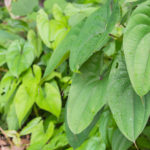Discorea Villosa
Dioscorea Villosa

Cell toxin (Ib). TM: South America, Africa. Pharm. MM: steroid hormones.
They have been used to treat bilious colic and rheumatism. The herb has no contraceptive or steroidal uses but is a source of starting materials to synthesize oral contraceptives (steroidal hormones) which are standardized prescription medicines, used only under medical supervision.
Dioscorea villosa origins are rooted in Africa and Asia. Dioscorea villosa is a perennial climber; rhizome tuberous; leaves green above, silvery below; flowers small. The alkaloids are highly toxic. Dioscorine: LD50 = 60mg/kg (mouse, i.p.).
They have been used to treat bilious colic and rheumatism. The herb has no contraceptive or steroidal uses but is a source of starting materials to synthesize oral contraceptives (steroidal hormones) which are standardized prescription medicines, used only under medical supervision.
Dioscorea villosa origins are rooted in Africa and Asia. Dioscorea villosa is a perennial climber; rhizome tuberous; leaves green above, silvery below; flowers small. The alkaloids are highly toxic. Dioscorine: LD50 = 60mg/kg (mouse, i.p.).
One such natural source is dioscin and diosgenin, a steroidal sapogenin, first isolated by Tsukamoto from the yam Dioscorea tokoro, but which can also be found in the tubers of other species of the Dioscoreae (Dioscorea villosa, D. mexicana and D. composita).
Diosgenin is also a constituent of many other plants such as Trillium erectum10, Solanum lyratum11, Tribulus terrestis12 and Paris polyphylla13. The hydrogenated form of diosgenin, tigogenin, can be found in Chlorogalum pomeridianum bulbs, Tribulus terrestis15, and Solanum paniculatum.
One such natural source is dioscin and diosgenin, a steroidal sapogenin, first isolated by Tsukamoto from the yam Dioscorea tokoro, but which can also be found in the tubers of other species of the Dioscoreae (Dioscorea villosa, D. mexicana and D. composita).
Diosgenin is also a constituent of many other plants such as Trillium erectum10, Solanum lyratum11, Tribulus terrestis12 and Paris polyphylla13. The hydrogenated form of diosgenin, tigogenin, can be found in Chlorogalum pomeridianum bulbs, Tribulus terrestis15, and Solanum paniculatum.
In the so-called Marker synthesis, diosgenin could be transformed to progesterone, which was used in the first combined oral contraceptive pills. While Dioscorea plants grow in various countries such as India, South Africa and China, the large-scale production of steroidal hormones by semi-synthesis from diosgenin and related sapogenins left a mark on the Mexican chemical industry and led to the founding of Syntex in Mexico.
In the so-called Marker synthesis, diosgenin could be transformed to progesterone, which was used in the first combined oral contraceptive pills. While Dioscorea plants grow in various countries such as India, South Africa and China, the large-scale production of steroidal hormones by semi-synthesis from diosgenin and related sapogenins left a mark on the Mexican chemical industry and led to the founding of Syntex in Mexico.